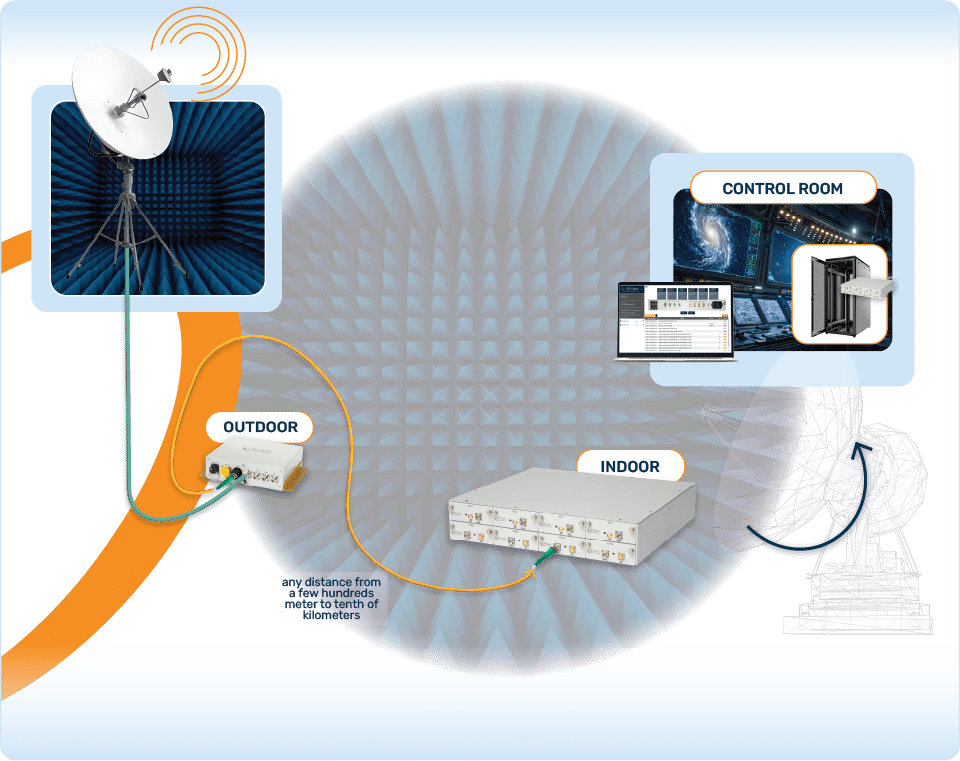
Anechoic Chambers
Electromagnetic compatibility (EMC), antenna radiation pattern measurements, and target simulators all make use of Anechoic Cambers. These chambers use walls of RF absorptive materials to make delicate and precise measurements in a controlled environment devoid of external RF interference. RFOptic’s RF to Fiber converter solutions are optimized for applications within these chambers, ensuring accurate and reliable results during tests.
WHY RFoF INSTEAD OF COAX FOR ANECHOIC CHAMBERS?
Traditional coaxial cables often present challenges in anechoic chambers, including signal loss, weight, and their own susceptibility to electromagnetic interference. RF over Fiber technology provides a practical solution by extending transmission distances without signal degradation, immunity to EMI and very wide bandwidth. Phase controlled RFoF multilinks can be used to extend the reach of specialized test equipment (VNA) used in measurements and provide accurate measurements under motion where that is needed.
KEY CHARACTERISTICS
RFOptic’s RFoF systems for anechoic chambers cover broad bandwidths up to 67GHz. The technology integrates low-noise and power amplifiers as required for optimum performance in both transmit and receive paths. Special feedback paths and signals enable precise amplitude and phase calibration that offer unprecedented measurement accuracy and repeatability. The same technology is often extended to outdoor antenna ranges. With RFoF technology these outdoor ranges can perform well at much higher frequencies although they require much longer cable lengths. These RFoF systems ensure precise signal management tailored to specific testing requirements.
FREQUENCY RANGE & RF COVERAGE
The RFoF systems provide extensive coverage capabilities, capable of handling significant distances typically required in anechoic chamber setups. They are designed to accommodate various frequency ranges, ensuring compatibility with diverse RF devices under test.
SYSTEM CONFIGURATION EXAMPLE
In its simplest application an RFoF system consists of two a transmitter and receiver sets each connected via single-mode fiber passing through the wall of the chamber. The RF signal source and measurement equipment can be positioned outside the chamber. One RFoF link delivers the signal from the source into the chamber while the second RFoF link conducts the DUT output signal back to the test equipment. More advanced setups may include additional RFoF links to provide and extended full 2-port remote VNA interface including phase correction channels where the DUT or the test source are set in motion within the chamber. Those applications of RFoF links in anechoic chambers and antenna ranges maintain the integrity of the RF signals and enhance the chamber’s functionality and usability.
Benefits
- Improved Communication: The RF over Fiber system significantly improves communication reliability and coverage. Personnel could now communicate seamlessly even in previously problematic areas.
- Enhanced Safety: Reliable communication enhances safety protocols, enabling quick response to emergencies and improved coordination during daily operations.
- Lower Maintenance Costs: The system’s robust design and reduced signal degradation minimizes the need for frequent maintenance, leading to cost savings.
- Operational Efficiency: With reliable communication channels established, operational efficiency increases as personnel could collaborate effectively, leading to smoother workflows and reduced downtime.
- Scalability: The modular nature of the RF over Fiber system allows for easy scalability as the mine site expanded or new communication needs arose.
REMOTE MONITORING AND CONTROL (M&C)
The integrated control interface provides real-time monitoring of RF and optical levels, allowing engineers to adjust parameters seamlessly during testing. This capability ensures optimal performance and facilitates quick troubleshooting if issues arise, enhancing testing efficiency.
SYSTEM DEPLOYMENT (EXAMPLE)
The system has an RFoF indoor unit in the upper part of the mine which is connected to an antenna array by coax cables. Three outdoor Single Mode Fibers (SMF) cables were run from the indoor unit to the three lower floors of the mine and connected to RFoF terminals at each floor. Lan connection was set up to all terminals. The upgraded system improved coverage and reduced signal degradation, achieving better safety and communication throughout the mine.
CONCLUSION
The RF over Fiber solution revolutionized communication at the customer’s mine site, enhancing safety, efficiency, and productivity. This innovative technology has demonstrated its value in transforming mining operations through reliable, cost-effective, and scalable connectivity.
Contact Us







